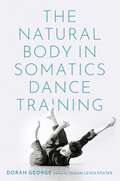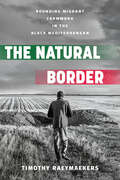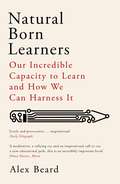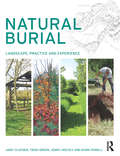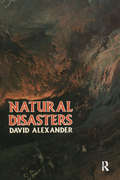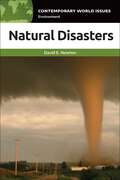- Table View
- List View
Natur-Kultur-Verhältnisse bei Bruno Latour: Relation(en) und Differenzierung(en) zugleich (BestMasters)
by André HinderlichDas Verhältnis des Menschen zur Natur beschäftigt die Soziologie seit ihrem Entstehen und ist in Anbetracht der Klimakrise und anderer mit ihr netzwerkartig verbundener Problemlagen ein Thema von besonderer Aktualität. In der Spätmoderne vollzieht sich ein Bruch mit der dualistischen Auffassung von Natur versus Kultur, unter anderem im Denken des französischen Philosophen und Soziologen Bruno Latour, welcher als einer der Hauptvertreter der Science & Technology Studies (STS) gilt. André Hinderlich verfolgt mit der vorliegenden Publikation eine begriffliche Ordnung und theoretische Klärung der mannigfaltigen Ausführungen, Versatzstücke und Konzepte zur prominent gewordenen Akteur-Netzwerk-Theorie (ANT), mit Fokus auf dem Verhältnis der Begriffspaare 'Relation(en)' und 'Differenzierung(en)'. Dies führt notwendigerweise über Latour hinaus, zu ergänzenden naturphilosophischen Reflexionen sowie weiteren Methodologien innerhalb der Umweltsoziologie.
Natur und Bildung: Interdisziplinäre fachdidaktische und pädagogische Perspektiven (Sozial- und Kulturgeographie #63)
by Sophia Feige Nicola Sophie RichterFragen nach dem Verhältnis zwischen Natur und Menschen bzw. der Gesellschaft sind in Anbetracht zunehmender globaler Krisen aktueller denn je. Die komplexen Herausforderungen des 21. Jahrhunderts erfordern einen interdisziplinären Blick, um sie in Forschung, Vermittlung und Praxis tiefgründig durchdringen und verstehen zu können. In welchem Verhältnis stehen dabei Natur, Bildung und die Perspektiven unterschiedlicher Fachrichtungen? Die Beiträger*innen widmen sich sowohl praktischen als auch theoretischen Dimensionen. Dabei loten sie verschiedene fachdidaktische und pädagogische Potenziale aus, die in einer Auseinandersetzung mit den Zusammenhängen von Bildungsprozessen sowie dem weiten Begriffsfeld »Natur« schlummern.
Natur und Staat: Zur politischen Theorie der deutschen Romantik (Sozialwissenschaftliche Studien #17)
by Volker StanslowskiNatur, Wissenschaft und Ganzheit: Über die Welterfahrung des Menschen
by Wolfgang BöcherAusgangspunkt ist einmal die Erkenntnis der Begrenztheit traditioneller und wissenschaftlicher Ansätze für das Verständnis menschlicher Wirklichkeit und zum anderen die Notwendigkeit für alle Bemühungen um Menschen, sich an der - auch biologischen - Wirklichkeit des Menschen zu orientieren. Auf dieser Grundlage wird ein großer Bogen gespannt zwischen der Welt der anorganischen Natur und der Welt des Bewußtseins und menschlicher Gesellschaften. Dabei werden auch die starre Abgrenzung zwischen Natur- und Geisteswissenschaften überwunden und Brücken zwischen unterschiedlichen Disziplinen geschlagen. Somit stellt das Buch auch eine naturwissenschaftliche Begründung ganzheitlicher Denk- und Verstehensansätze dar und ist zugleich ein Versuch, von der "Weisheit" der Natur zu lernen und Menschen zu helfen, sich mit sich selbst und in der Welt besser zurechtzufinden.
Natural and Cultural Diversity in the Himalaya (SpringerBriefs in Environmental Science)
by Vishwambhar Prasad SatiThe Himalaya is the new folded mountain system – the tallest and the youngest in the world. It has a rich diversity – natural and cultural, and diversity in all walks of life. Most of its uniqueness is unknown because of its remoteness. Even, the native people are not aware of them. This book aims to describe the uniqueness of the Central Himalaya in terms of its natural and cultural diversity in detail. Supported by original figures and primary data, this book is empirically tested. It is mainly based on observation and participation and the use of a qualitative approach. Although lots of work has been carried out on the various aspects of the Himalayan region yet, a detailed description of the natural and cultural diversity is yet to be done. This book steps forward to elaborate on some of the unique natural and cultural features of the Central Himalaya, which are worthy to be known about. It contains a total of 10 chapters. Four chapters are devoted to natural diversity and four chapters comprise cultural diversity. Besides, the introduction and conclusions are the first and the last chapters of the book, respectively. The book is the first of its kind and will be useful to all stakeholders – students of all standards, research scholars, academicians, policymakers, native people, tourists, and the general public.
The Natural and Societal Challenges of the Northern Sea Route: A Reference Work
by WillyØstreng, Michael Tamvakis, Gennady N. Semanov, Willy Østreng, Kjell A. Moe, Anatoly L. Kolodkin, Kazuhiko Kamesaki, Johnny-Leo L. Jernsletten, Vladimir D. Grishchenko, Alexander G. Granberg, Edgar Gold, Douglas Brubaker, Lawson W. BrighamYohei Sasakawa The Northern Sea Route is the shortest shipping route connecting the Far East and Europe. However, the route has been practically inaccessible to commercial vessels, due to the harsh natural conditions in the area, which make navigation possible for only a small part of the year, and then only with an icebreaker leading the way. Opening the Northern Sea Route would greatly facilitate international shipping, making two routes - a northbound one through the NSR, and a southbound one through Suez- available throughout all seasons. The Northern Sea Route would also help to boost economic development, including the exploitation of natural resources in Russian regions along the coast of the Arctic Ocean. Thanks to international cooperation, we have been able to set up and successfully conclude a special project to investigate the possibilities of developing the Northern Sea Route as a commercial route, while protecting the environment, wildlife and peoples of the Arctic Ocean region. This represents a highly significant step in terms of future global development.
The Natural Body in Somatics Dance Training
by Doran GeorgeFrom its beginnings as an alternative and dissident form of dance training in the 1960s, Somatics emerged at the end of the twentieth century as one of the most popular and widespread regimens used to educate dancers. It is now found in dance curricula worldwide, helping to shape the look and sensibilities of both dancers and choreographers and thereby influencing much of the dance we see onstage worldwide. One of the first books to examine Somatics in detail and to analyse how and what it teaches in the dance studio, The Natural Body in Somatics Dance Training considers how dancers discover and assimilate new ways of moving and also larger cultural values associated with those movements. The book traces the history of Somatics, and it also details how Somatics developed in different locales, engaging with local politics and dance histories so as to develop a distinctive pedagogy that nonetheless shared fundamental concepts with other national and regional contexts. In so doing it shows how dance training can inculcate an embodied politics by guiding and shaping the experience of bodily sensation, constructing forms of reflexive evaluation of bodily action, and summoning bodies into relationship with one another. Throughout, the author focuses on the concept of the natural body and the importance of a natural way of moving as central to the claims that Somatics makes concerning its efficacy and legitimacy.
NATURAL BODY SOMATICS DANCE TRAINING C
by Doran GeorgeFrom its beginnings as an alternative and dissident form of dance training in the 1960s, Somatics emerged at the end of the twentieth century as one of the most popular and widespread regimens used to educate dancers. It is now found in dance curricula worldwide, helping to shape the look and sensibilities of both dancers and choreographers and thereby influencing much of the dance we see onstage worldwide. One of the first books to examine Somatics in detail and to analyse how and what it teaches in the dance studio, The Natural Body in Somatics Dance Training considers how dancers discover and assimilate new ways of moving and also larger cultural values associated with those movements. The book traces the history of Somatics, and it also details how Somatics developed in different locales, engaging with local politics and dance histories so as to develop a distinctive pedagogy that nonetheless shared fundamental concepts with other national and regional contexts. In so doing it shows how dance training can inculcate an embodied politics by guiding and shaping the experience of bodily sensation, constructing forms of reflexive evaluation of bodily action, and summoning bodies into relationship with one another. Throughout, the author focuses on the concept of the natural body and the importance of a natural way of moving as central to the claims that Somatics makes concerning its efficacy and legitimacy.
The Natural Border: Bounding Migrant Farmwork in the Black Mediterranean
by Timothy RaeymaekersThe Natural Border tells the recent history of Mediterranean rural capitalism from the perspective of marginalized Black African farm workers. Timothy Raeymaekers shows how in the context of global supply chains and repressive border regimes, agrarian production and reproduction are based on fundamental racial hierarchies.Taking the example of the tomato—a typical 'Made in Italy' commodity—Raeymaekers asks how political boundaries are drawn around the land and the labor needed for its production, what technologies of exclusion and inclusion enable capitalist operations to take place in the Mediterranean agrarian frontier, and which practices structure the allocation, use and commodification of land and labor across the tomato chain. While the mobile infrastructures that mobilize, channel, commodify and segregate labor play a central role in the 'naturalization' of racial segregation, they are also terrains of contestation and power—and thus, as The Natural Border demonstrates, reflect the tense socio-ecological transformation the Mediterranean border space is going through today.
Natural Born Celebrities: Serial Killers in American Culture (The\heritage Of Sociology Ser.)
by David SchmidJeffrey Dahmer. Ted Bundy. John Wayne Gacy. Over the past thirty years, serial killers have become iconic figures in America, the subject of made-for-TV movies and mass-market paperbacks alike. But why do we find such luridly transgressive and horrific individuals so fascinating? What compels us to look more closely at these figures when we really want to look away? Natural Born Celebrities considers how serial killers have become lionized in American culture and explores the consequences of their fame. David Schmid provides a historical account of how serial killers became famous and how that fame has been used in popular media and the corridors of the FBI alike. Ranging from H. H. Holmes, whose killing spree during the 1893 Chicago World's Fair inspired The Devil in the White City, right up to Aileen Wuornos, the lesbian prostitute whose vicious murder of seven men would serve as the basis for the hit film Monster, Schmid unveils a new understanding of serial killers by emphasizing both the social dimensions of their crimes and their susceptibility to multiple interpretations and uses. He also explores why serial killers have become endemic in popular culture, from their depiction in The Silence of the Lambs and The X-Files to their becoming the stuff of trading cards and even Web sites where you can buy their hair and nail clippings. Bringing his fascinating history right up to the present, Schmid ultimately argues that America needs the perversely familiar figure of the serial killer now more than ever to manage the fear posed by Osama bin Laden since September 11. "This is a persuasively argued, meticulously researched, and compelling examination of the media phenomenon of the 'celebrity criminal' in American culture. It is highly readable as well."—Joyce Carol Oates
Natural Born Celebrities: Serial Killers in American Culture
by David SchmidJeffrey Dahmer. Ted Bundy. John Wayne Gacy. Over the past thirty years, serial killers have become iconic figures in America, the subject of made-for-TV movies and mass-market paperbacks alike. But why do we find such luridly transgressive and horrific individuals so fascinating? What compels us to look more closely at these figures when we really want to look away? Natural Born Celebrities considers how serial killers have become lionized in American culture and explores the consequences of their fame. David Schmid provides a historical account of how serial killers became famous and how that fame has been used in popular media and the corridors of the FBI alike. Ranging from H. H. Holmes, whose killing spree during the 1893 Chicago World's Fair inspired The Devil in the White City, right up to Aileen Wuornos, the lesbian prostitute whose vicious murder of seven men would serve as the basis for the hit film Monster, Schmid unveils a new understanding of serial killers by emphasizing both the social dimensions of their crimes and their susceptibility to multiple interpretations and uses. He also explores why serial killers have become endemic in popular culture, from their depiction in The Silence of the Lambs and The X-Files to their becoming the stuff of trading cards and even Web sites where you can buy their hair and nail clippings. Bringing his fascinating history right up to the present, Schmid ultimately argues that America needs the perversely familiar figure of the serial killer now more than ever to manage the fear posed by Osama bin Laden since September 11. "This is a persuasively argued, meticulously researched, and compelling examination of the media phenomenon of the 'celebrity criminal' in American culture. It is highly readable as well."—Joyce Carol Oates
Natural Born Learners: Our Incredible Capacity to Learn and How We Can Harness It
by Alex BeardLearning is the soul of our species. From our first steps to our last words, we are what we learn. But for all its obvious importance, learning has lost touch with human progress. We live in an information age, work in a knowledge economy, yet our schools are relics of an industrial era. Education insider Alex Beard takes us on a dazzling tour of the future of learning to show how we can - and why we must - do better. Tackling everything from artificial intelligence to our growing understanding of the infant brain, Natural Born Learners is a user's guide to transforming learning in the twenty-first century and roadmap to accessing our better future selves.
Natural Burial: Landscape, Practice and Experience
by Andy Clayden Trish Green Jenny Hockey Mark PowellThis book unravels the many different experiences, meanings and realities of natural burial. Twenty years after the first natural burial ground opened there is an opportunity to reflect on how a concept for a very different approach to caring for our dead has become a reality: new providers, new landscapes and a hybrid of new and traditional rituals. In this short time the natural burial movement has flourished. In the UK there are more than 200 sites, and the concept has travelled to North America, Holland, Australia, New Zealand and Japan. This survey of natural burials draws on interviews with those involved in the natural burial process – including burial ground managers, celebrants, priests, bereaved family, funeral directors – providing a variety of viewpoints on the concept as a philosophy and landscape practice. Site surveys, design plans and case studies illustrate the challenges involved in creating a natural burial site, and a key longitudinal case study of a single site investigates the evolving nature of the practice. Natural Burial is the first book on this subject to bring together all the groups and individuals involved in the practice, explaining the facts behind this type of burial and exploring a topic which is attracting significant media interest and an upsurge of sites internationally.
Natural Burial: Landscape, Practice and Experience
by Andy Clayden Trish Green Jenny Hockey Mark PowellThis book unravels the many different experiences, meanings and realities of natural burial. Twenty years after the first natural burial ground opened there is an opportunity to reflect on how a concept for a very different approach to caring for our dead has become a reality: new providers, new landscapes and a hybrid of new and traditional rituals. In this short time the natural burial movement has flourished. In the UK there are more than 200 sites, and the concept has travelled to North America, Holland, Australia, New Zealand and Japan. This survey of natural burials draws on interviews with those involved in the natural burial process – including burial ground managers, celebrants, priests, bereaved family, funeral directors – providing a variety of viewpoints on the concept as a philosophy and landscape practice. Site surveys, design plans and case studies illustrate the challenges involved in creating a natural burial site, and a key longitudinal case study of a single site investigates the evolving nature of the practice. Natural Burial is the first book on this subject to bring together all the groups and individuals involved in the practice, explaining the facts behind this type of burial and exploring a topic which is attracting significant media interest and an upsurge of sites internationally.
Natural Capitalism: The Next Industrial Revolution
by Paul Hawken Amory B. Lovins L. Hunter LovinsOn its first publication 10 years ago, Natural Capitalism rocked the world of business with its innovative new approach - an approach that fused ecological integrity with business acumen using the radical concept of natural capitalism. This 10th-anniversary edition features a new Introduction by Amory B. Lovins and Paul Hawken which updates the story to include the successes of the last decade. It clearly sets out the path that we must now take to ensure the future prosperity of our civilisation and our planet.
Natural Capitalism: The Next Industrial Revolution (PDF)
by Paul Hawken Amory B. Lovins L. Hunter LovinsOn its first publication 10 years ago, Natural Capitalism rocked the world of business with its innovative new approach - an approach that fused ecological integrity with business acumen using the radical concept of natural capitalism. This 10th-anniversary edition features a new Introduction by Amory B. Lovins and Paul Hawken which updates the story to include the successes of the last decade. It clearly sets out the path that we must now take to ensure the future prosperity of our civilisation and our planet.
Natural Disaster and Development in a Globalizing World
by Mark PellingThe number of humanitarian disasters triggered by a natural hazard has doubled every decade since the 1960s. At the same time, the global economic growth rate per capita is twice its 1960s value. Does this mean economic growth is independent of the impacts of natural disaster? Natural Disaster and Development in a Globalizing World is the first book to acknowledge the full implications of globalization for disaster and development. The contributors to this book fully examine: global processes and how they might affect disaster risk at the global scale. links between international issues - such as diplomatic relations, the growth of non-governmental organizations and the health of the international insurance industry - and disaster risk the interaction of these large scale forces with local conditions through case study analysis of individual disaster events. In his revealing work, author Pelling makes clear the links between global scale processes and local experiences of disaster, and underlies the difficulty of attributing blame for individual disasters on specific global pressures. He argues that action to reduce disaster must be coordinated at the local, national and global scales and that there is a need for greater integration across the physical and social sciences. In this context, the human rights agenda is seen as a way of moving disaster reduction efforts forward.
Natural Disaster and Development in a Globalizing World
by Mark PellingThe number of humanitarian disasters triggered by a natural hazard has doubled every decade since the 1960s. At the same time, the global economic growth rate per capita is twice its 1960s value. Does this mean economic growth is independent of the impacts of natural disaster? Natural Disaster and Development in a Globalizing World is the first book to acknowledge the full implications of globalization for disaster and development. The contributors to this book fully examine: global processes and how they might affect disaster risk at the global scale. links between international issues - such as diplomatic relations, the growth of non-governmental organizations and the health of the international insurance industry - and disaster risk the interaction of these large scale forces with local conditions through case study analysis of individual disaster events. In his revealing work, author Pelling makes clear the links between global scale processes and local experiences of disaster, and underlies the difficulty of attributing blame for individual disasters on specific global pressures. He argues that action to reduce disaster must be coordinated at the local, national and global scales and that there is a need for greater integration across the physical and social sciences. In this context, the human rights agenda is seen as a way of moving disaster reduction efforts forward.
Natural Disaster and Nuclear Crisis in Japan: Response and Recovery after Japan's 3/11 (Nissan Institute/Routledge Japanese Studies)
by Jeff KingstonThe March 2011 earthquake and tsunami in Japan plunged the country into a state of crisis. As the nation struggled to recover from a record breaking magnitude 9 earthquake and a tsunami that was as high as thirty-eight meters in some places, news trickled out that Fukushima had experienced meltdowns in three reactors. These tragic catastrophes claimed some 20,000 lives, initially displacing some 500,000 people and overwhelming Japan's formidable disaster preparedness. This book brings together the analysis and insights of a group of distinguished experts on Japan to examine what happened, how various institutions and actors responded and what lessons can be drawn from Japan’s disaster. The contributors, many of whom experienced the disaster first hand, assess the wide-ranging repercussions of this catastrophe and how it is already reshaping Japanese culture, politics, energy policy, and urban planning.
Natural Disaster and Nuclear Crisis in Japan: Response and Recovery after Japan's 3/11 (Nissan Institute/Routledge Japanese Studies)
by Jeff KingstonThe March 2011 earthquake and tsunami in Japan plunged the country into a state of crisis. As the nation struggled to recover from a record breaking magnitude 9 earthquake and a tsunami that was as high as thirty-eight meters in some places, news trickled out that Fukushima had experienced meltdowns in three reactors. These tragic catastrophes claimed some 20,000 lives, initially displacing some 500,000 people and overwhelming Japan's formidable disaster preparedness. This book brings together the analysis and insights of a group of distinguished experts on Japan to examine what happened, how various institutions and actors responded and what lessons can be drawn from Japan’s disaster. The contributors, many of whom experienced the disaster first hand, assess the wide-ranging repercussions of this catastrophe and how it is already reshaping Japanese culture, politics, energy policy, and urban planning.
Natural Disasters
by David AlexanderAs a well balanced and fully illustrated introductory text, this book provides a comprehensive overview of the physical, technological and social components of natural disaster. The main disaster-producing agents are reviewed systematically in terms of geophysical processes and effects, monitoring, mitigation and warning. The relationship between disasters and society is examined with respect to a wide variety of themes, including damage assessment and prevention, hazard mapping, emergency preparedness, the provision of shelter and the nature of reconstruction. Medical emergencies and the epidemiology of disasters are described, and refugee management and aid to the Third World are discussed. A chapter is devoted to the sociology, psychology, economics and history of disasters.; In many parts of the world the toll of death, injury, damage and deprivation caused by natural disasters is becoming increasingly serious. Major earthquakes, volcanic eruptions, droughts, floods and other similar catastrophes are often followed by large relief operations characterized by substantial involvement of the international community. The years 1990-2000 have therefore been designated by the United Nations as the International Decade for Natural Disaster Reduction.; The book goes beyond mere description and elevates the field of natural catastrophes to a serious academic level. The author's insights and perspectives are also informed by his practical experience of being a disaster victim and survivor, and hence the unique perspective of a participant observer. Only by surmounting the boundaries between disciplines can natural catastrophe be understood and mitigation efforts made effective. Thus, this book is perhaps the first completely interdisciplinary, fully comprehensive survey of natural hazards and disasters. It has a clear theoretical basis and it recognizes the importance of six fundamental approaches to the field, which it blends carefully in the text in order to avoid the partiality of previous works. It covers the earth and social sciences, as well as engineering, architecture and development studies. This breadth is made possible by virtue of a strong emphasis on simple principles of the interaction of geophysical agents with human vulnerability and response.; All students of environmental sciences/studies and geography should find this book useful. It is an introductory text which treats this dramatic subject area as something demanding serious academic treatment and not just as an assemblage of horror stories.; This book is intended for undergraduate students in geography and environmental studies/sciences. The book should also appeal to any professional or researcher concerned with man- environment relations, whether in social science or natural science or engineering.
Natural Disasters
by David AlexanderAs a well balanced and fully illustrated introductory text, this book provides a comprehensive overview of the physical, technological and social components of natural disaster. The main disaster-producing agents are reviewed systematically in terms of geophysical processes and effects, monitoring, mitigation and warning. The relationship between disasters and society is examined with respect to a wide variety of themes, including damage assessment and prevention, hazard mapping, emergency preparedness, the provision of shelter and the nature of reconstruction. Medical emergencies and the epidemiology of disasters are described, and refugee management and aid to the Third World are discussed. A chapter is devoted to the sociology, psychology, economics and history of disasters.; In many parts of the world the toll of death, injury, damage and deprivation caused by natural disasters is becoming increasingly serious. Major earthquakes, volcanic eruptions, droughts, floods and other similar catastrophes are often followed by large relief operations characterized by substantial involvement of the international community. The years 1990-2000 have therefore been designated by the United Nations as the International Decade for Natural Disaster Reduction.; The book goes beyond mere description and elevates the field of natural catastrophes to a serious academic level. The author's insights and perspectives are also informed by his practical experience of being a disaster victim and survivor, and hence the unique perspective of a participant observer. Only by surmounting the boundaries between disciplines can natural catastrophe be understood and mitigation efforts made effective. Thus, this book is perhaps the first completely interdisciplinary, fully comprehensive survey of natural hazards and disasters. It has a clear theoretical basis and it recognizes the importance of six fundamental approaches to the field, which it blends carefully in the text in order to avoid the partiality of previous works. It covers the earth and social sciences, as well as engineering, architecture and development studies. This breadth is made possible by virtue of a strong emphasis on simple principles of the interaction of geophysical agents with human vulnerability and response.; All students of environmental sciences/studies and geography should find this book useful. It is an introductory text which treats this dramatic subject area as something demanding serious academic treatment and not just as an assemblage of horror stories.; This book is intended for undergraduate students in geography and environmental studies/sciences. The book should also appeal to any professional or researcher concerned with man- environment relations, whether in social science or natural science or engineering.
Natural Disasters: A Reference Handbook (Contemporary World Issues)
by David E. NewtonThis book provides a detailed introduction to natural disasters and the ways in which they have had and continue to have, profound effects on human society.Natural Disasters: A Reference Handbook surveys the impact of these events on human civilization. The opening chapter provides a general history and background of the major types of natural disasters, including earthquakes, volcanic eruptions, severe storms, and forest fires. The information presented in this introduction allows the reader to better understand current issues, problems, and solutions related to natural disasters discussed in subsequent chapters.The book covers the role of natural disasters in human life from earliest recorded history (and, to some extent, even earlier) to the present day. It provides an extensive variety of resources that encourage readers to learn more about the topics discussed. The book is intended for readers in the late middle school to high school age range, as well as adults who may have a special interest in the subject.
Natural Disasters: A Reference Handbook (Contemporary World Issues)
by David E. NewtonThis book provides a detailed introduction to natural disasters and the ways in which they have had and continue to have, profound effects on human society.Natural Disasters: A Reference Handbook surveys the impact of these events on human civilization. The opening chapter provides a general history and background of the major types of natural disasters, including earthquakes, volcanic eruptions, severe storms, and forest fires. The information presented in this introduction allows the reader to better understand current issues, problems, and solutions related to natural disasters discussed in subsequent chapters.The book covers the role of natural disasters in human life from earliest recorded history (and, to some extent, even earlier) to the present day. It provides an extensive variety of resources that encourage readers to learn more about the topics discussed. The book is intended for readers in the late middle school to high school age range, as well as adults who may have a special interest in the subject.
'Natural’ Disasters and Everyday Lives: Floods, Climate Justice and Marginalisation in India (Diverse Perspectives on Creating a Fairer Society)
by Suddhabrata Deb RoyDisasters have a widescale impact with drastic consequences on human lives, especially those who are marginalised by the wider society. Proposing a fresh approach towards analysing the politics of disasters, climate change and climate justice, 'Natural’ Disasters and Everyday Lives explores the relationship between citizens, the State and the society in the context of the Global South’s highly underdeveloped areas. Drawing on both theoretical frameworks and lived experience, this is the first book to document the lives of people affected by floods in the Barak Valley, a flood prone area in Southern Assam, which is also one of the most underdeveloped regions of South Asia. Narrating the fear and perils of living in an underdeveloped area in India during natural disasters, Suddhabrata Deb Roy draws from interviews conducted in Silchar, the largest and most developed urban settlement in the Barak Valley, during the floods of 2022 – the worst flood in the region in over 100 years – and during 2024 to expose the processes through which the people of the region suffer from developmental negligence and socio-political apathy. Examining the intersections of natural disasters and marginality, the author relates Marx’s ideas on humanism, nature, alienation and economic development to ideas around climate justice, marginalisation and urbanisation, taking into context the contradictions posed by factors such as class, caste, gender and race in highly underdeveloped regions in India. Recognising that these issues are addressed quite differently in the Global North, Deb Roy connects flooding in northeastern India to the context of the broader politics surrounding climate change and climate justice in the Global South, making this book important and powerful reading for countering today’s climate emergency.






